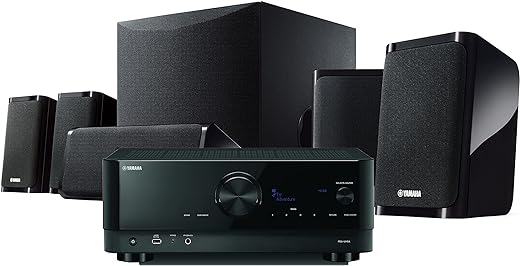What Are the Essential Components of a Home Theater System?
Are you a movie lover who craves the ultimate cinematic experience right in the comfort of your own home? If so, then you’ve come to the right place. In this blog post, we will delve into the world of home theater systems and explore the essential components that are crucial in delivering a truly immersive entertainment experience. Whether you’re a tech enthusiast or simply someone who enjoys a good movie night, understanding the key elements of a home theater system will not only enhance your viewing pleasure but also help you create a personal cinematic haven that is second to none. So grab your popcorn and get ready to embark on a journey into the realm of home theater systems.
Top-rated Home Theater Systems for an Immersive Entertainment Experience
Display
When it comes to creating an immersive home theater experience, the display is a crucial component that cannot be overlooked. Whether you opt for a high-definition television or a projector and screen setup, the display is responsible for delivering crisp and vibrant visuals that truly bring movies, TV shows, and games to life. In this blog section, we will delve into the key factors to consider when choosing the right display for your home theater setup.
Resolution: Setting the Standard for Visual Clarity
One of the most important considerations when selecting a display is its resolution. Resolution refers to the number of pixels on the screen, and it directly affects the level of detail and clarity you can expect from your viewing experience. Here are some common resolutions and their benefits:
- Full HD (1080p): This resolution is considered the standard for high-definition content and provides sharp visuals with great color accuracy.
- 4K Ultra HD: With four times the number of pixels as Full HD, 4K Ultra HD offers exceptional detail and stunning clarity, making it ideal for larger screens.
- 8K Ultra HD: The latest advancement in display technology, 8K Ultra HD takes visual clarity to the next level, delivering an unparalleled level of detail and realism.
Size: Finding the Perfect Fit for Your Viewing Space
The size of the display is another important factor to consider, as it can greatly impact your viewing experience. Too small of a display can result in a diminished immersive effect, while a display that is too large for your viewing space can cause discomfort. Here are some tips to help you find the ideal size for your home theater:
- Measure your viewing distance: A general rule of thumb is to sit at a distance that is approximately 1.5 to 2.5 times the diagonal screen size. For example, if you have a 65-inch screen, the recommended viewing distance would be between 8 and 13 feet.
- Consider the room layout: Take into account the layout of your room, including the distance between the display and seating area, as well as any obstructions that may affect the viewing angles.
- Opt for a larger screen for a cinematic experience: If you have a spacious room dedicated to your home theater, a larger screen can help recreate the immersive feeling of a commercial cinema.
Display Technology: Exploring the Options
The type of display technology used in your home theater setup can significantly impact the quality of the visuals. Here are a few popular display technologies:
- LED/LCD: LED/LCD displays use an array of light-emitting diodes (LEDs) to illuminate liquid crystal display (LCD) panels, resulting in bright and vibrant images. They are known for their wide color gamut and energy efficiency.
- OLED: OLED displays use organic compounds that emit light when an electric current passes through them. This technology allows for individual pixels to be turned on or off, resulting in deep blacks, excellent contrast, and vibrant colors.
- Laser projection: Laser projectors use laser light sources instead of traditional lamps, offering improved brightness, color accuracy, and longevity. They are particularly well-suited for larger screen sizes and rooms with ambient light.
Making an Informed Decision
In summary, when selecting a display for your home theater system, consider the resolution, size, and display technology that best suits your needs and preferences. Here are some key takeaways to help you make an informed decision:
- Choose a resolution that aligns with your preferences and the content you enjoy.
- Determine the ideal screen size based on your viewing distance and room layout.
- Explore different display technologies to find the one that offers the best balance of visual quality, performance, and price.
Remember, investing in a high-quality display will significantly enhance your home theater experience, allowing you to enjoy your favorite movies, shows, and games with stunning visuals that transport you into a whole new world of entertainment.
Audio
When it comes to creating an immersive and exceptional home theater experience, audio plays a crucial role. The combination of speakers, subwoofers, and audio receivers work together to deliver high-quality sound that brings movies, music, and games to life. In this blog section, we will delve deeper into the world of audio, discussing its significance and the key components that contribute to an outstanding audio performance.
1. Speakers: The Foundation of Great Sound
Speakers are the primary components responsible for reproducing sound in a home theater system. They come in various types, including floor-standing speakers, bookshelf speakers, and in-wall or in-ceiling speakers. Each type has its own strengths and benefits, but ultimately, they all contribute to creating a surround sound experience.
Key points:
- Floor-standing speakers: Ideal for larger rooms, these speakers deliver powerful and immersive sound.
- Bookshelf speakers: Compact and versatile, they are great for smaller spaces or as part of a multi-channel setup.
- In-wall or in-ceiling speakers: Perfect for a clean and unobtrusive installation, they can be discreetly placed within the walls or ceiling.
2. Subwoofers: Adding Depth and Impact
Subwoofers are dedicated speakers designed to reproduce low-frequency sounds, adding depth and impact to the audio experience. They are responsible for delivering the rumbling bass notes that can be felt as well as heard, enhancing the overall immersion and realism of the sound.
Key points:
- Subwoofers come in various sizes, with larger ones typically offering deeper and more powerful bass.
- Placement of the subwoofer is important for optimal performance, with corner placement often recommended for the best bass response.
- Some subwoofers feature adjustable settings, allowing you to fine-tune the bass output to your preferences or room acoustics.
3. Audio Receivers: The Command Center
Audio receivers act as the central hub of a home theater system, connecting and controlling all the audio components. They receive audio signals from various sources, such as Blu-ray players, gaming consoles, or streaming devices, and distribute them to the speakers and subwoofers.
Key points:
- Audio receivers come with different features and capabilities, including support for different audio formats and connectivity options.
- Some receivers offer advanced audio processing technologies, such as Dolby Atmos or DTS:X, which provide a more immersive and three-dimensional sound experience.
- It’s important to choose a receiver that matches the requirements of your audio setup and can accommodate future upgrades.
Media Source
Are you looking to enhance your home theater experience by watching movies, TV shows, or listening to music? One key component you need is a reliable media source. In this blog section, we will discuss the importance of choosing the right media source for your home theater system, the different types of media sources available, and the key factors to consider when making your decision.
Types of Media Sources
Blu-ray Players
Blu-ray players have long been a popular choice for media playback. They offer high-definition video and audio quality, making them ideal for movie enthusiasts who crave a cinematic experience at home. Some notable Blu-ray player brands include Sony, LG, and Panasonic.
Key benefits of Blu-ray players include:
- Support for various video and audio codecs, allowing you to play a wide range of media formats.
- Additional features like 4K upscaling, which enhances the picture quality of non-4K content.
- Availability of streaming services, allowing you to access popular platforms like Netflix and Amazon Prime Video directly from the player.
Streaming Devices
Streaming devices have gained popularity in recent years due to their convenience and versatility. These compact devices connect to your home theater system and allow you to stream content from popular services like Netflix, Hulu, and Spotify. Leading streaming device brands include Roku, Amazon Fire TV, and Apple TV.
Key benefits of streaming devices include:
- Wide compatibility with streaming services, ensuring you have access to a vast library of content.
- Ease of use, with intuitive interfaces and user-friendly remote controls.
- Ability to stream content in 4K Ultra HD and HDR, providing stunning picture quality.
Gaming Consoles
For those who are avid gamers, gaming consoles can serve as an all-in-one media source. Popular gaming consoles like the Xbox Series X and PlayStation 5 not only offer an immersive gaming experience but also provide access to a wide range of media content.
Key benefits of gaming consoles include:
- Ability to play video games, watch movies, and stream music, all in one device.
- Integration with popular streaming services, allowing you to easily switch between gaming and media playback.
- Enhanced audio capabilities, such as support for Dolby Atmos, providing a more immersive sound experience.
Factors to Consider
When choosing a media source for your home theater system, there are several factors to consider. Here are some key points to keep in mind:
- Format support: Ensure that the media source supports the audio and video formats you prefer, such as Dolby Digital or DTS for audio, and MP4 or MKV for video.
- Connectivity options: Check the available ports and wireless connectivity options of the media source to ensure compatibility with your existing setup.
- Streaming capabilities: If you rely heavily on streaming services, make sure the media source offers easy access to your preferred platforms.
- User interface: Consider the ease of navigation and user-friendliness of the media source’s interface, as this will greatly impact your overall experience.
- Additional features: Look for any additional features that may enhance your media playback, such as 4K upscaling, voice control, or support for virtual assistants like Alexa or Google Assistant.
Making an Informed Decision
Choosing the right media source for your home theater system is crucial to ensure an enjoyable and immersive entertainment experience. By considering the different types of media sources available, evaluating the key factors mentioned above, and comparing the features and benefits of various brands and models, you can make an informed decision that aligns with your preferences and requirements.
Remember, investing in a reliable and high-quality media source will greatly enhance your home theater experience, allowing you to fully immerse yourself in your favorite movies, TV shows, and music.
Seating and Room Acoustics
Creating a captivating and immersive movie-watching experience goes beyond just having a high-resolution screen and top-notch sound system. It also involves thoughtful consideration of seating options, room layout, and acoustic treatments. In this blog section, we will delve into these key elements and provide you with valuable insights to optimize your viewing environment.
Choosing the Right Seating
When it comes to seating options for your home theater, comfort and functionality are paramount. Here are some factors to consider:
- Ergonomics: Look for seating that offers proper lumbar support and adjustable features to accommodate various body types and preferences. Brands such as La-Z-Boy and Herman Miller offer a wide range of ergonomic seating options designed with user comfort in mind.
- Reclining Features: Opting for reclining seats can significantly enhance your comfort during long movie marathons. Manufacturers like Palliser and Octane Seating offer a variety of reclining options, including power recliners and models with built-in cup holders and storage compartments.
- Material and Upholstery: Choose seating materials that are durable, easy to clean, and provide a luxurious feel. Leather options from Natuzzi or Stressless offer a sophisticated touch, while fabric choices from Ashley Furniture or Lane Home Furnishings provide a cozy and inviting atmosphere.
Room Layout Considerations
To optimize your home theater’s acoustics and viewing experience, proper room layout is essential. Consider the following tips:
- Optimal Viewing Distance: Position your seating at a distance that allows for an immersive experience without causing eye strain. As a general rule, aim for a viewing distance that is about 1.5 to 2.5 times the diagonal screen size.
- Screen Placement: Ensure that the screen is positioned at a height and angle that provides a clear view for all viewers. Consider using mounts or stands from reputable brands like Sanus or Echogear to achieve the desired screen placement.
- Seating Arrangement: Arrange your seating in a way that offers unobstructed views of the screen for every viewer. Consider using sectional sofas or theater-style seating setups from brands like Homelegance or Seatcraft to maximize seating capacity without compromising comfort.
Enhancing Acoustics with Treatments
Achieving optimal room acoustics can greatly enhance the audio experience in your home theater. Consider the following acoustic treatments:
- Absorption: Use acoustic panels or foam from brands like Auralex or Gik Acoustics to reduce sound reflections and echoes, resulting in clearer and more detailed audio.
- Diffusion: Install diffusers, such as those offered by RealTraps or Primacoustic, to scatter sound waves and create a more natural and spacious sonic environment.
- Bass Traps: Address low-frequency issues by incorporating bass traps into your space. Brands like GIK Acoustics or Ready Acoustics offer effective bass trapping solutions to control room resonances.
Key Takeaways for Building the Perfect Home Theater System
In conclusion, by ensuring that your home theater system is equipped with a high-quality display, immersive audio setup, suitable media source, and optimized seating and room acoustics, you can create an exceptional entertainment experience. These essential components will enhance your enjoyment and make your home theater system truly remarkable. So, whether you’re a movie enthusiast or a gaming fanatic, investing in these components will undoubtedly elevate your home entertainment to a whole new level.
















Could you expand on the importance of room acoustics in a home theater system? How can it be optimized for the best sound experience?
Certainly! Room acoustics play a crucial role in achieving optimal sound quality. It involves factors like sound absorption, reflection, and diffusion. I’ll explain it in detail in an upcoming article. Stay tuned!
One tip I would suggest is to invest in a good soundbar or surround sound system. The audio quality can really make a difference in immersing yourself in the movie.
That’s great to hear! OLED TVs are known for their deep blacks and vibrant colors, making them an excellent choice for a home theater setup.
I recently purchased a 65-inch OLED TV for my home theater system and the display quality is absolutely stunning. It really enhances the overall movie-watching experience.